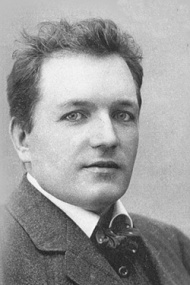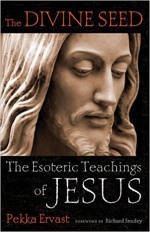Pekka Ervast: Difference between revisions
No edit summary |
No edit summary |
||
| Line 20: | Line 20: | ||
Earnestly seeking for the meaning of life took Ervast eventually to point where he said: now comes clarity or death. And then in the year 1896 he went through an experience of rebirth, in which he was transformed by a pure light. This experience formed the basis for his theosophical work. | Earnestly seeking for the meaning of life took Ervast eventually to point where he said: now comes clarity or death. And then in the year 1896 he went through an experience of rebirth, in which he was transformed by a pure light. This experience formed the basis for his theosophical work. | ||
=== | === Universal Brotherhood and Theosophical Society === | ||
During the years 1896-1898, Ervast belonged to the Theosophical Society Point Loma, then | During the years 1896-1898, Ervast belonged to the Theosophical Society Point Loma, then named Universal Brotherhood or [[Universal Brotherhood and Theosophical Society]]. He was its representative in Finland. Later this branch of the Theosophical Movement was known for its headquarters colony in [[Point Loma|Point Loma, California]]. | ||
He joined the esoteric school led by [[Katherine Tingley|Mrs. Katherine Tingley]]. Ervast intensively followed [[meditation]] instructions of the esoteric school. After a while he was able to do conscious [[Occultism|occult]] investigation and work in the invisible world. For instance, he was able to observe various states in the afterlife (a compilation of his teachings on this topic is available in English as the e-book ''From Death to Rebirth''). | |||
=== Theosophical Society, Adyar === | === Theosophical Society, Adyar === | ||
Revision as of 14:45, 11 April 2019
UNDER CONSTRUCTION
UNDER CONSTRUCTION
Pekka Ervast (1875-1934) was founder of Finnish Section of Theosophical Society based in Adyar. He was a writer, lecturer and linguist.
Personal life
Pekka Ervast was born on December 26, 1875, in Helsinki, Finland. His mother tongue was Swedish, and he belonged to the Lutheran Church like the vast majority of Finns did at the time. His father was a public officer; Ervast’s mother died when he was nine years old. Even as a child, he was very versatile in languages: for instance, he learnt to read French at the age of five or six, and at the age of twelve he began writing a comparative grammatical study of nine different languages.
He passed his matriculation exams in 1893 and started studying romance languages and Sanskrit at the University of Helsinki, which was known by a different name then. Beginning in childhood he had experiences of extrasensory perception.
He died on May 22, 1934 in Helsinki.
Theosophical Society involvement
In January 1894, Ervast got acquainted with Theosophy and next year joined the Scandinavian Section of the Theosophical Society. When the so-called Judge crisis broke, Ervast initially took the position of William Quan Judge in the dispute. The crisis in the Theosophical Society was painful to Ervast, who had believed in Universal Brotherhood, especially among theosophists.
Spiritual awakening
Earnestly seeking for the meaning of life took Ervast eventually to point where he said: now comes clarity or death. And then in the year 1896 he went through an experience of rebirth, in which he was transformed by a pure light. This experience formed the basis for his theosophical work.
Universal Brotherhood and Theosophical Society
During the years 1896-1898, Ervast belonged to the Theosophical Society Point Loma, then named Universal Brotherhood or Universal Brotherhood and Theosophical Society. He was its representative in Finland. Later this branch of the Theosophical Movement was known for its headquarters colony in Point Loma, California.
He joined the esoteric school led by Mrs. Katherine Tingley. Ervast intensively followed meditation instructions of the esoteric school. After a while he was able to do conscious occult investigation and work in the invisible world. For instance, he was able to observe various states in the afterlife (a compilation of his teachings on this topic is available in English as the e-book From Death to Rebirth).
Theosophical Society, Adyar
In 1898, Ervast joined the Theosophical Society based in Adyar, Chennai, India. He corresponded with many of the main theosophical workers in his time. For instance, he met Society President Colonel Henry S. Olcott for the first time in 1900, and they got along very well. He also met the Countess Wachtmeister, who accompanied TS founder H. P. Blavatsky in her last years. The Countess warned Ervast not to enter politics in Finland.
Theosophical book publishing
In 1922, the Finnish Section reported that it "has bought Theosophical books for about 15,000 frnk. from O/Y Tietaja (a joint-stock-company, which was started by Mr. Pekka Ervast and now owned by some of his friends)..."[1]
Esoteric Christianity and Rosicrucianism
Ervast valued highly Leo Tolstoy’s interpretation on the Sermon on The Mount, and he never gave up the ethics of the Sermon on the Mount. Ervast did not, however, accept Tolstoy’s very critical view on art, nor Tolstoy’s appreciation of physical labor as only true form of work.
Writings in English
- From Death to Rebirth. Literary Society of the Finnish Rosy Cross, 2017. Compiled and edited by Jouni Marjanen, Antti Savinainen, and Jouko Sorvali. Foreword by Richard Smoley. This is also available as an audio book.
- The Divine Seed: The Esoteric Teachings of Jesus. Second edition published by Quest Books, 2010. Reviewed in TheoSophia (NZ) 72.4 (Summer, 2011), 29.
- The Key to the Kalevala. 1916. The English version was first published in 1999 by Blue Dolphin Publishing and the e-book version in 2018 by Literary Society of the Finnish Rosy Cross.
- The Mission of the Theosophical Society. 1921.
- Astral Schools. 1929. The English e-book version was published in 2008 by the PekkaErvast.net website.
- The Sermon on the Mount. 1933.
- H. P. B.: The Sphinx of the XIXth Century. 1933.
- Spiritual Knowledge. Pekka Ervast Series Book 1. Helsinki: Aatma, 2018. Print and Kindle editions are available.
- The Inner God and Happiness. Pekka Ervast Series Book 2. Helsinki: Aatma, 2018. Print and Kindle editions are available.
Additional resources
- Ervast, Pekka. "Reports of the TS in Finland" The Theosophist v39 (July, 1918), 392.
- General Reports of the Theosophical Society provide reports written by Pekka Ervast during the years that he was leader of the Finnish Section of the TS Adyar.
- PekkaErvast.net. Website in Finnish.
Notes
- ↑ John Sonck, "T. S. in Finland" General Report of the Theosophical Society 1922 (Adyar, Madras, India: Theosophical Publishing Company, 1922), 96-97.

